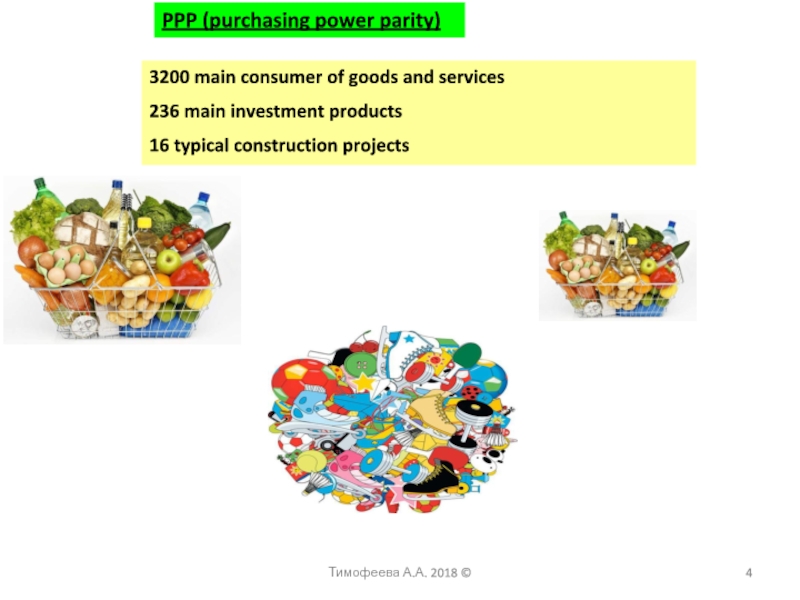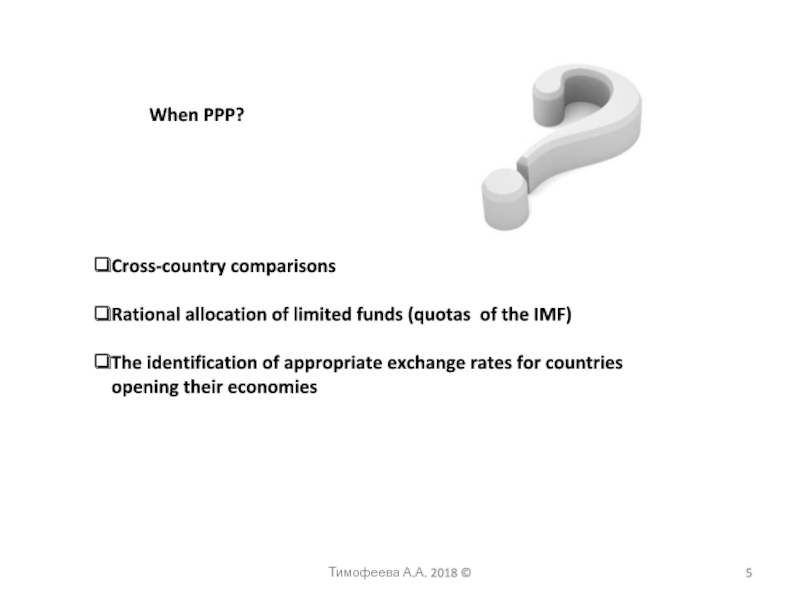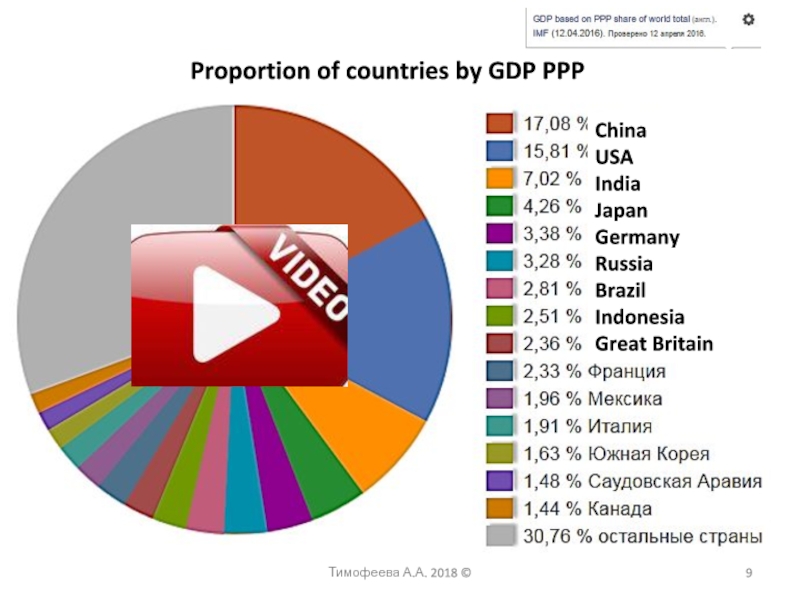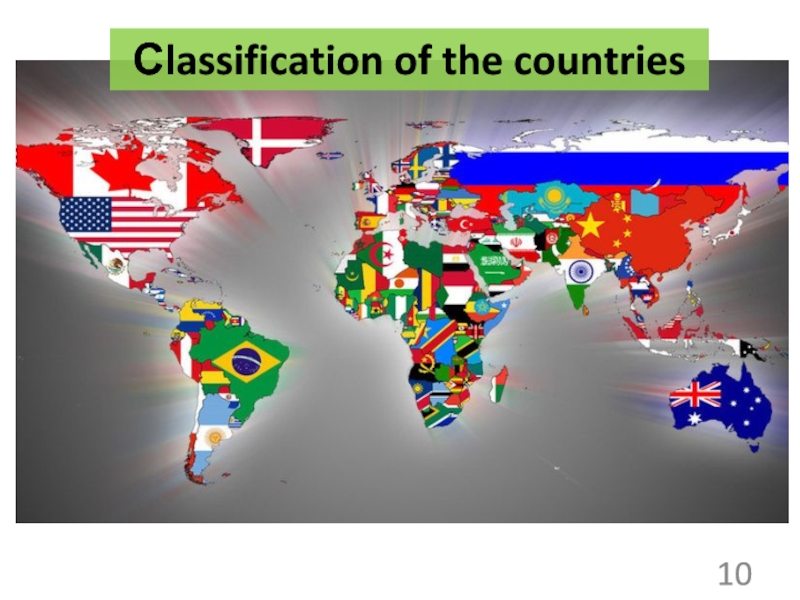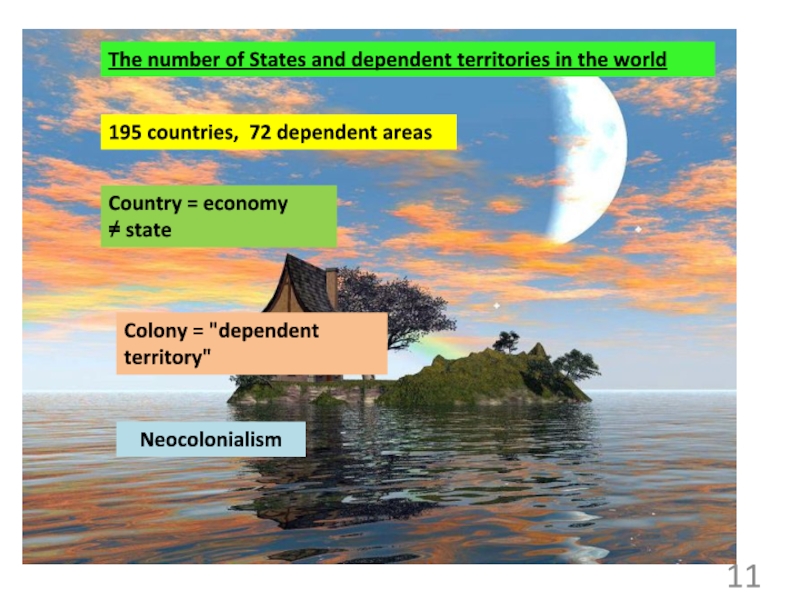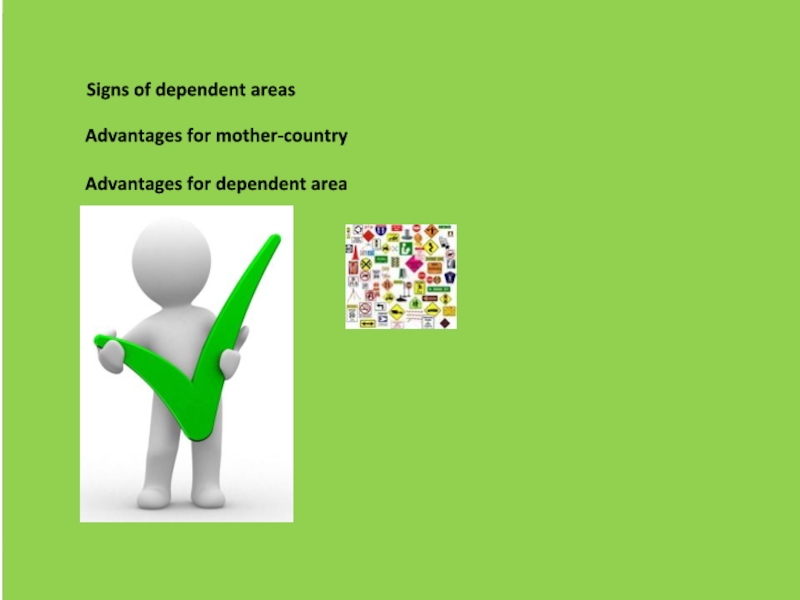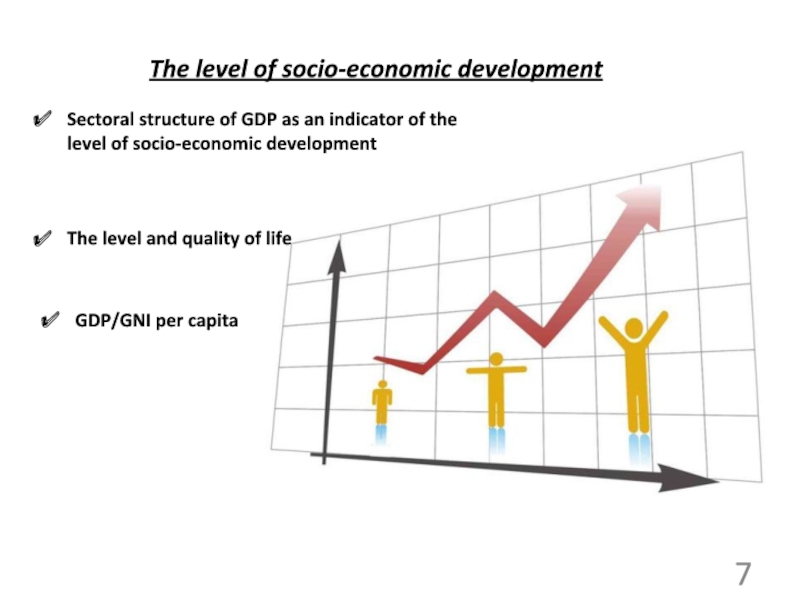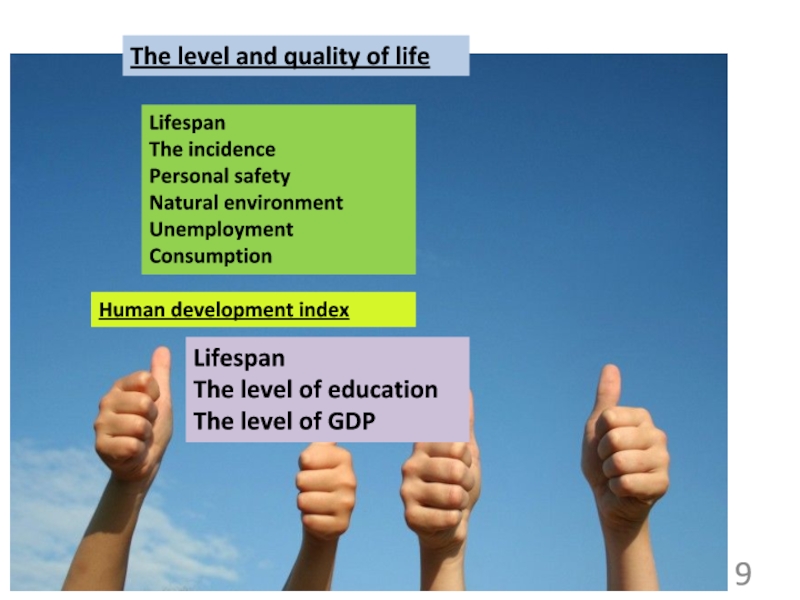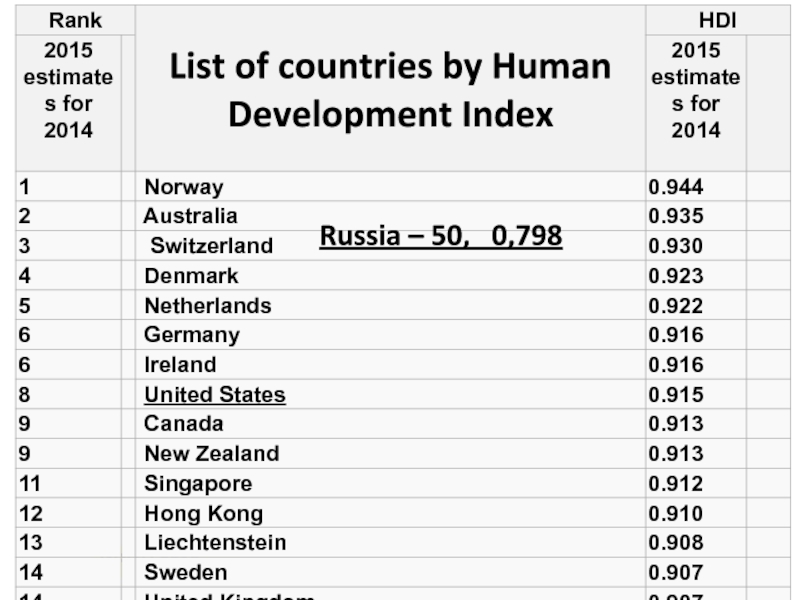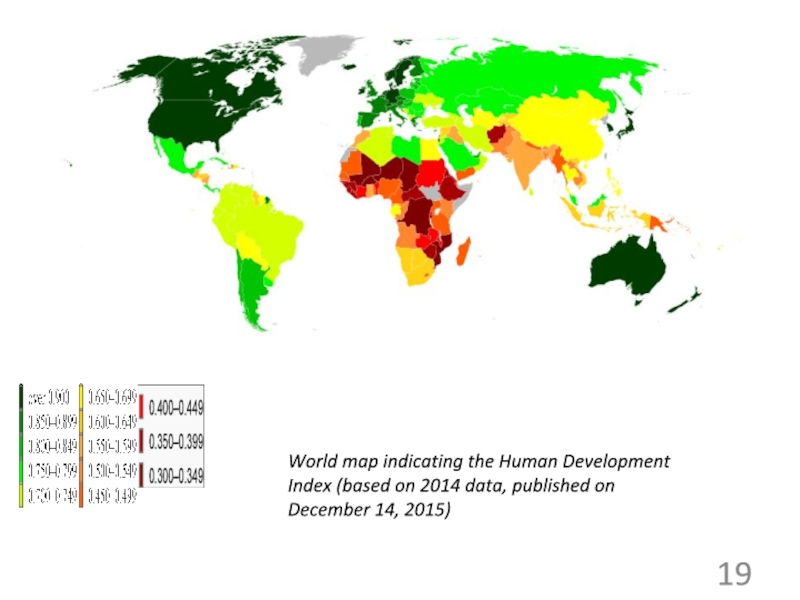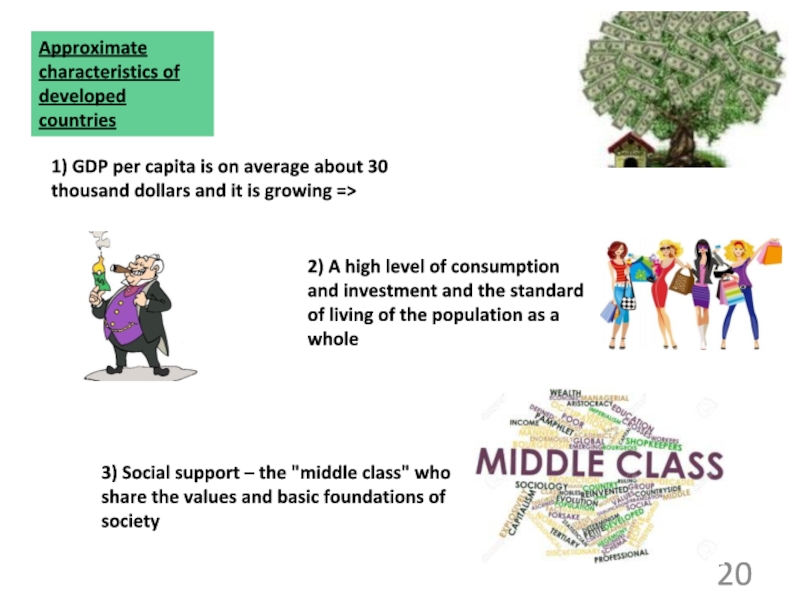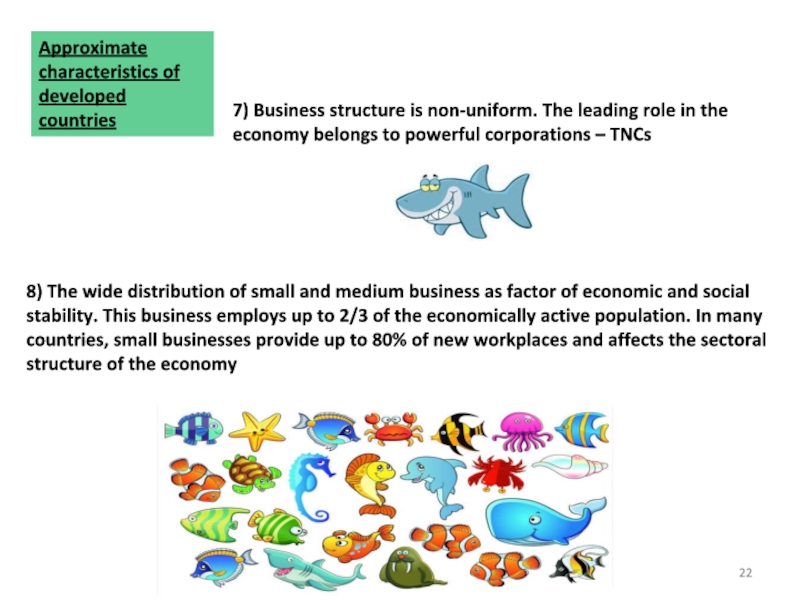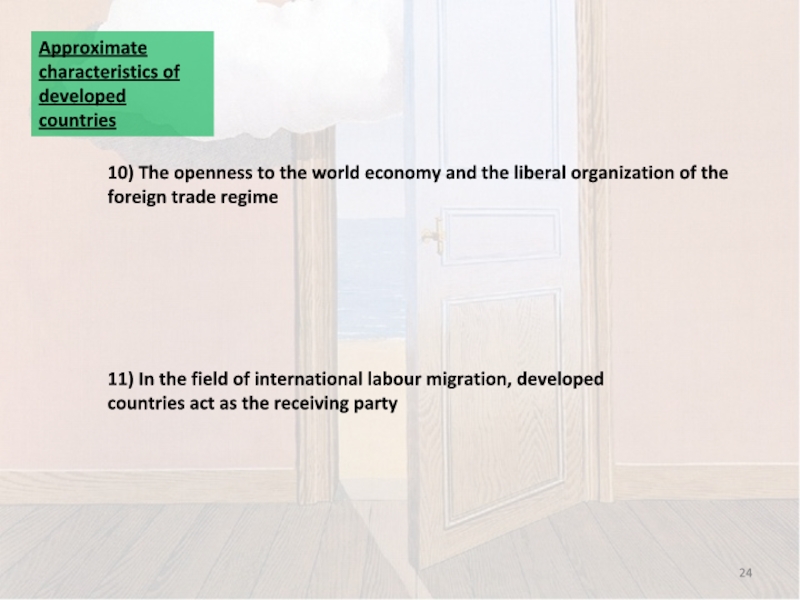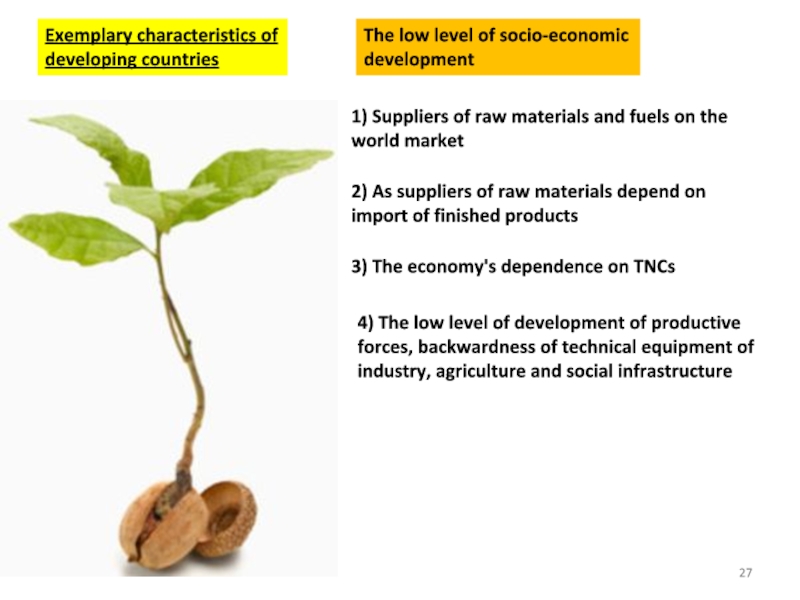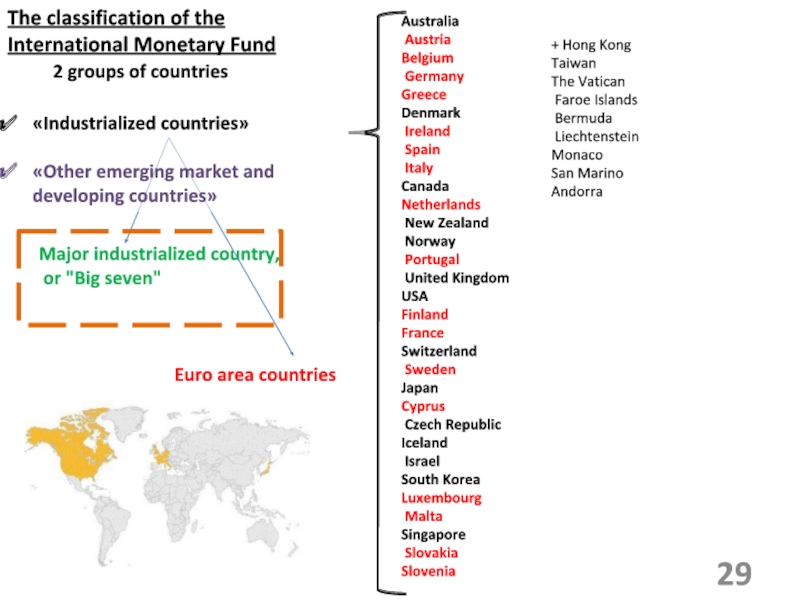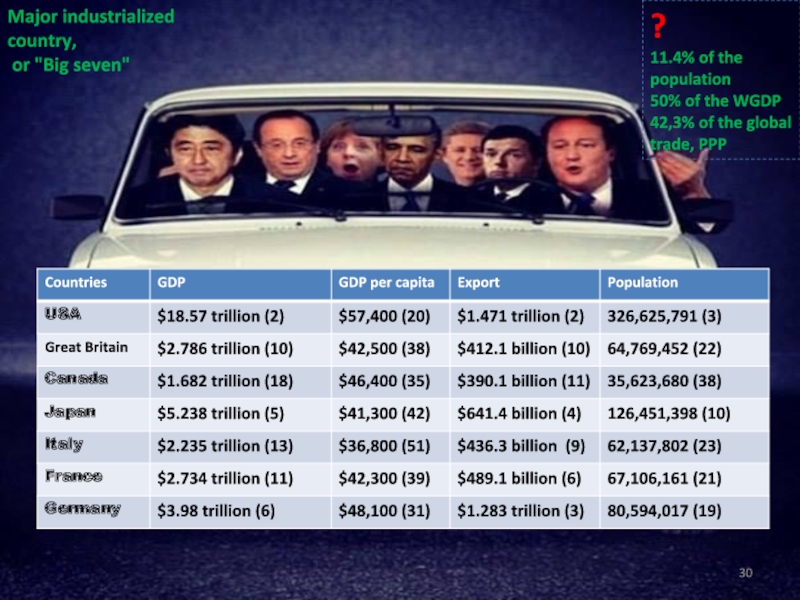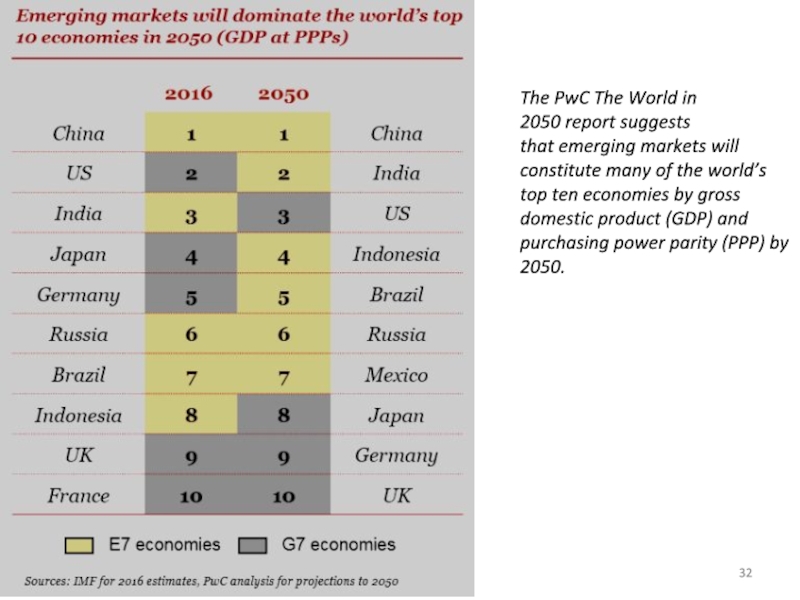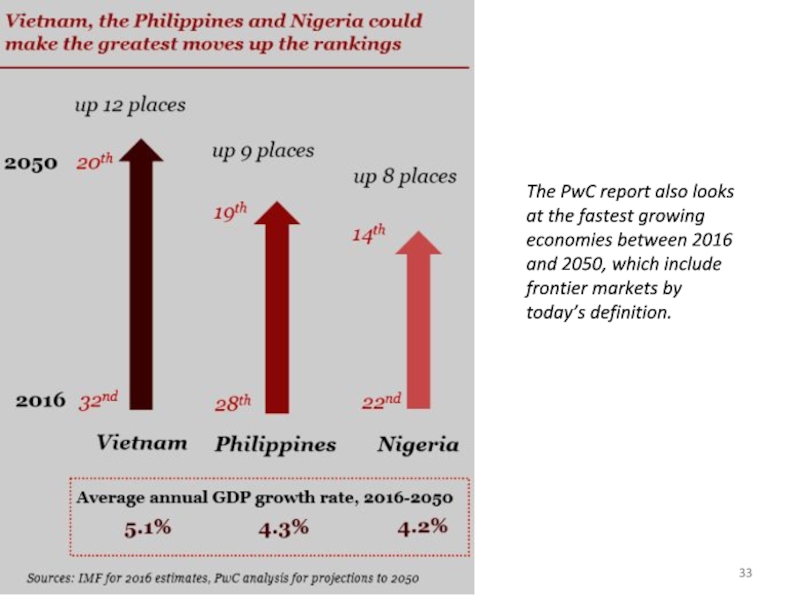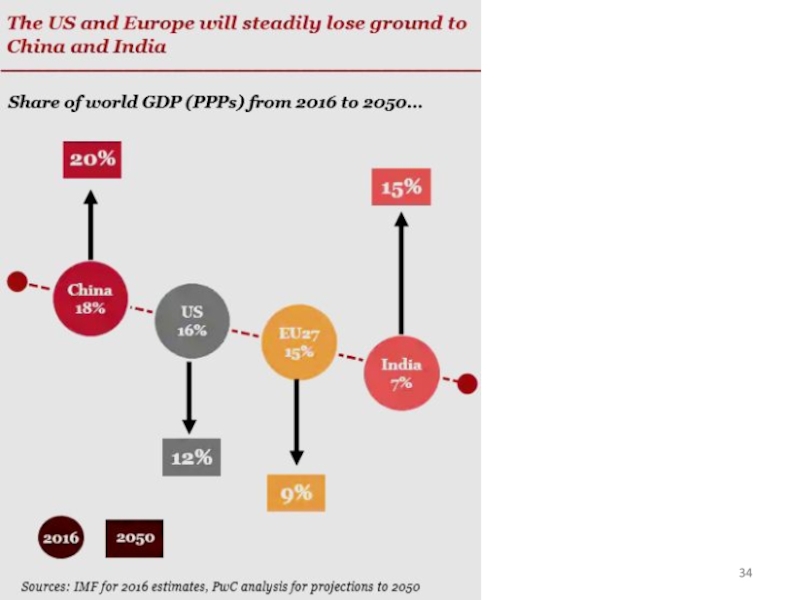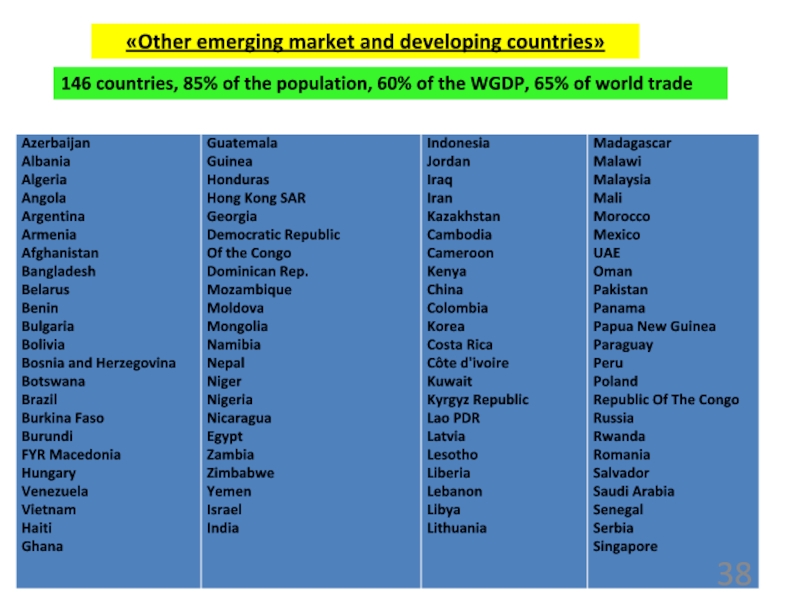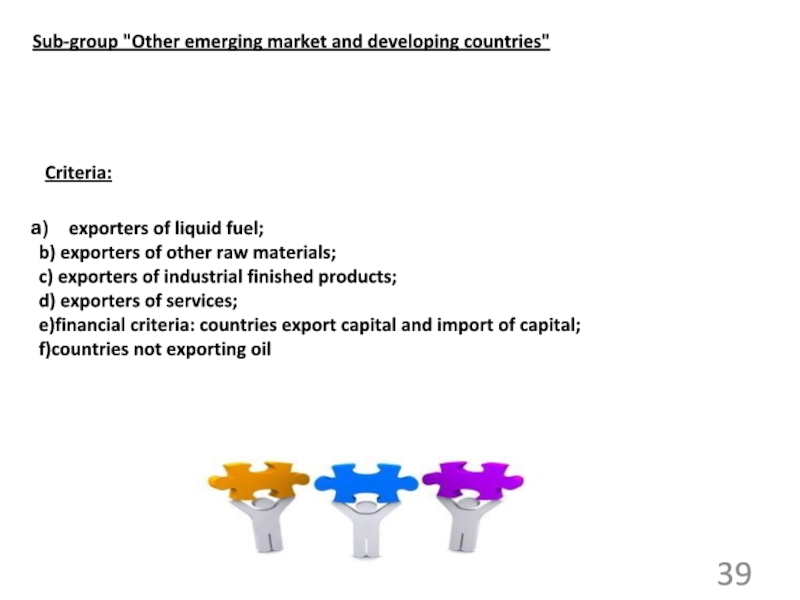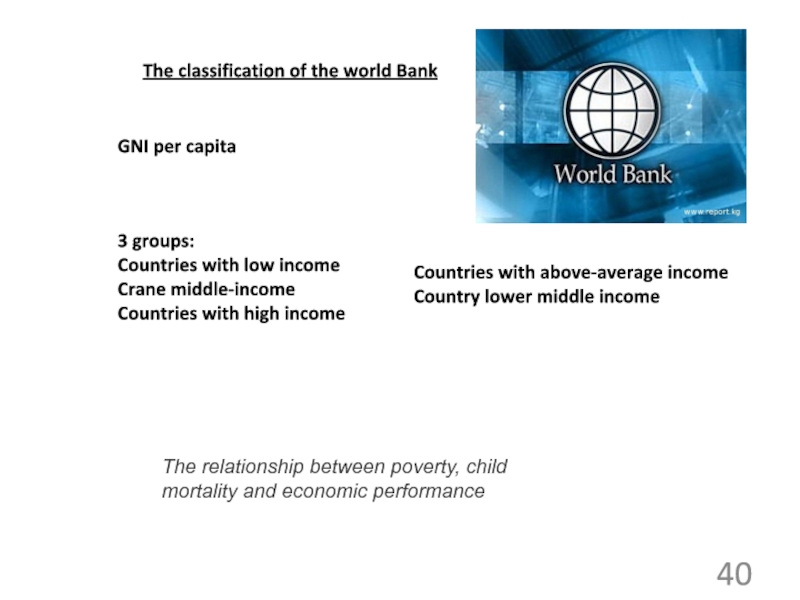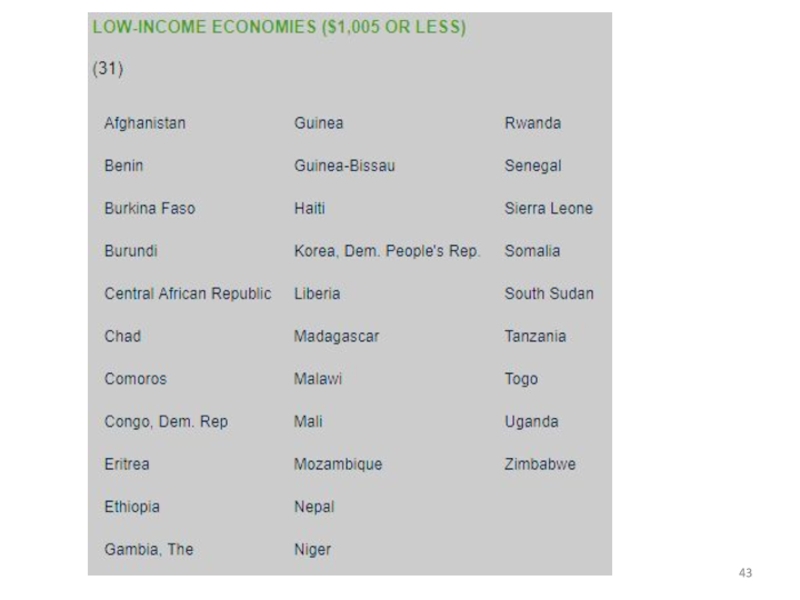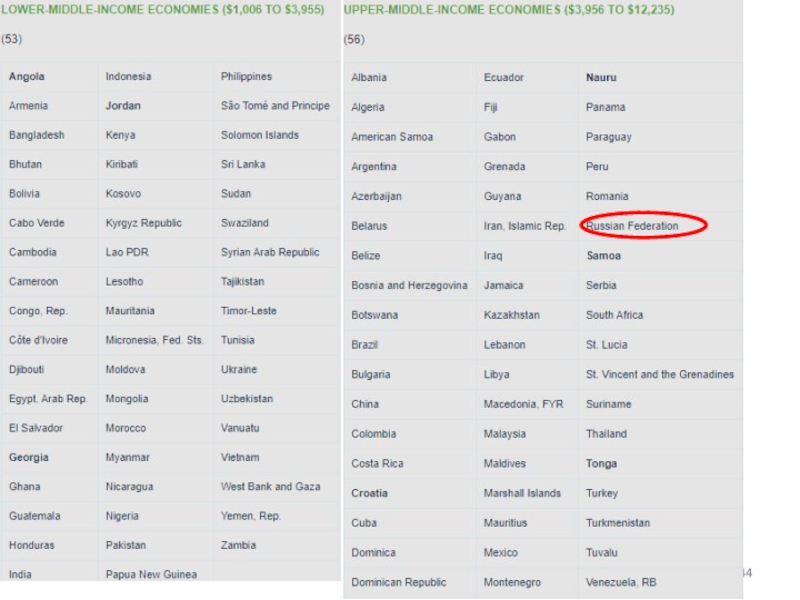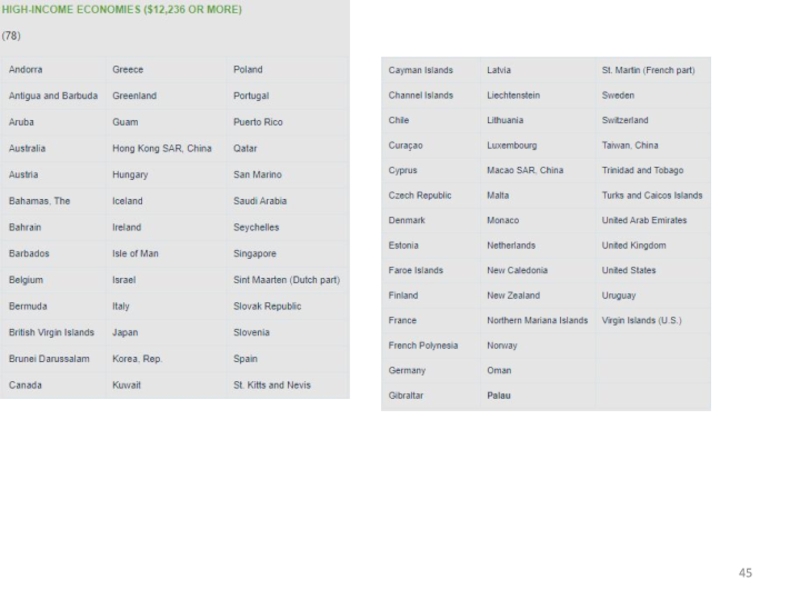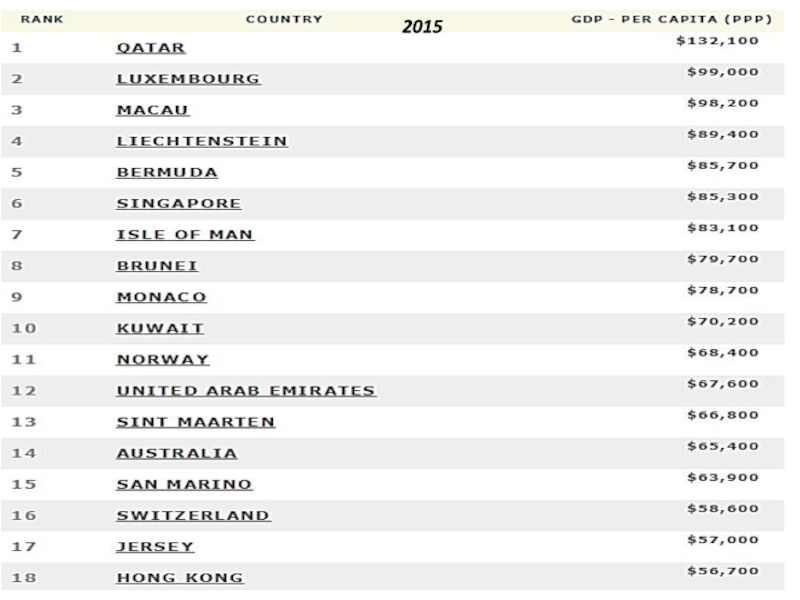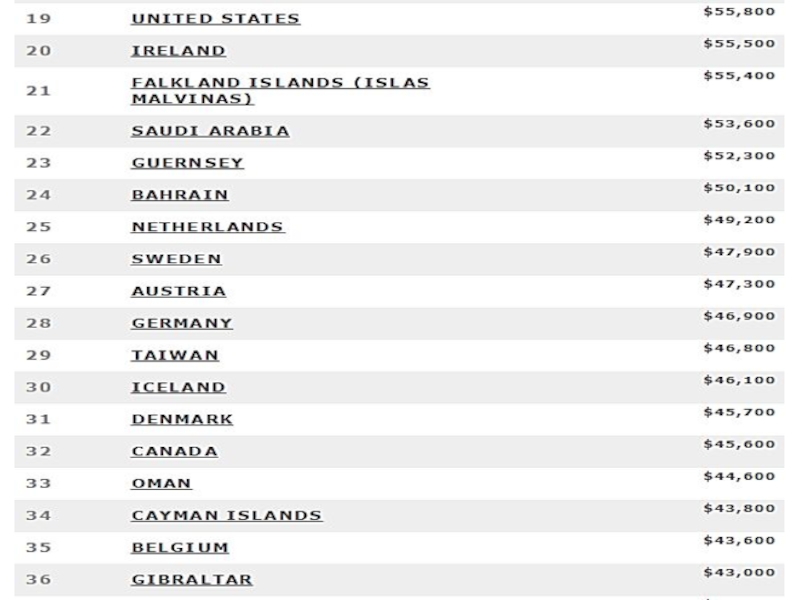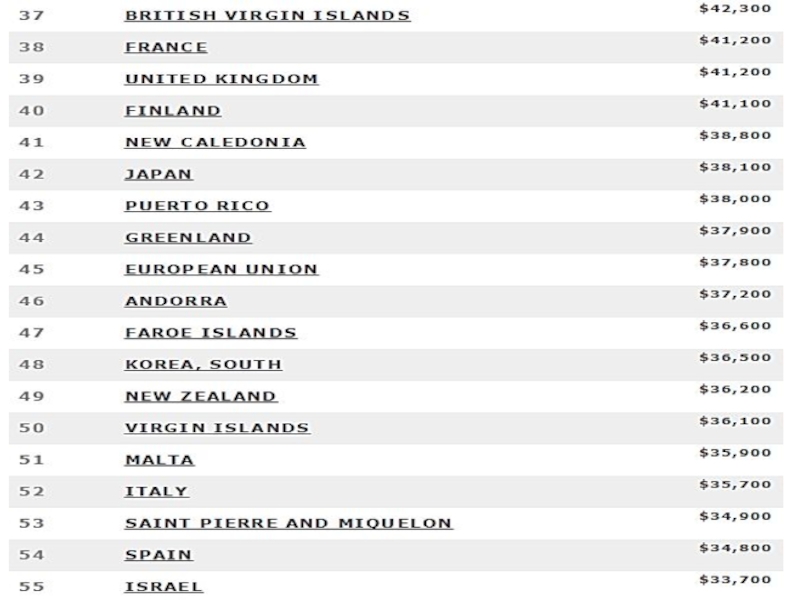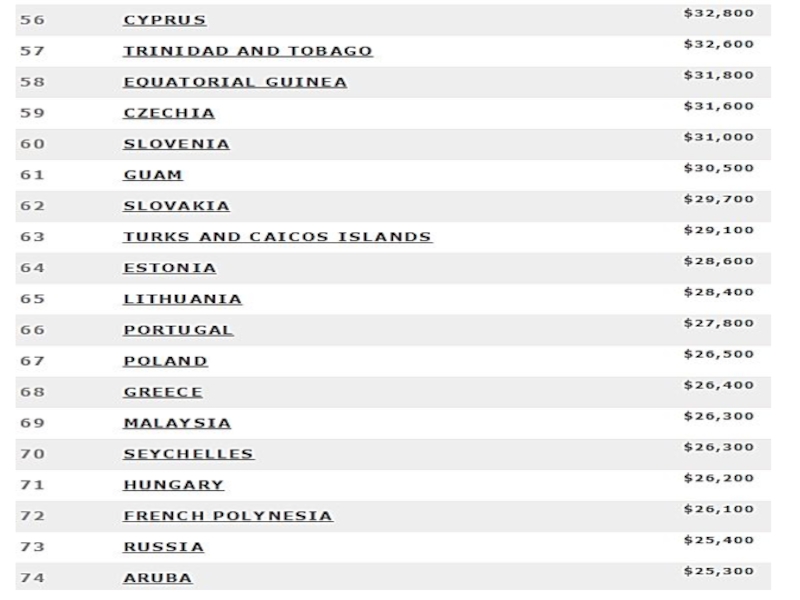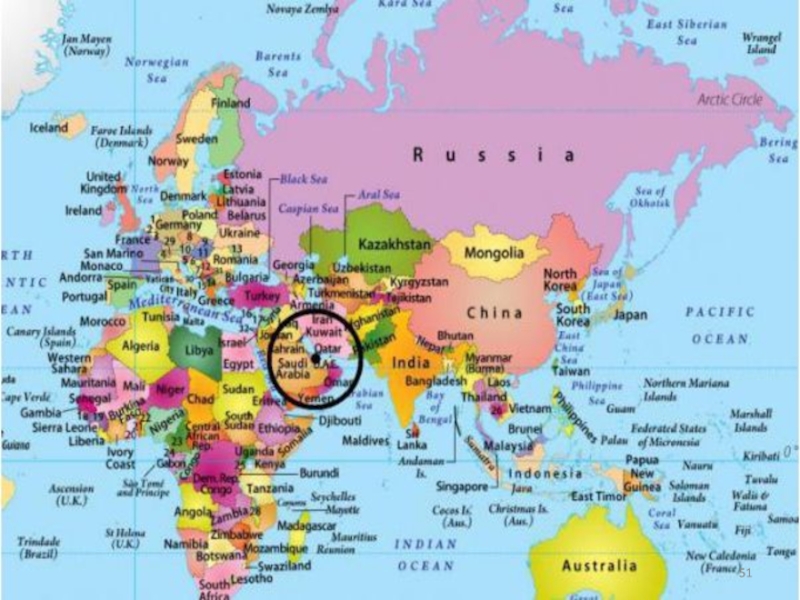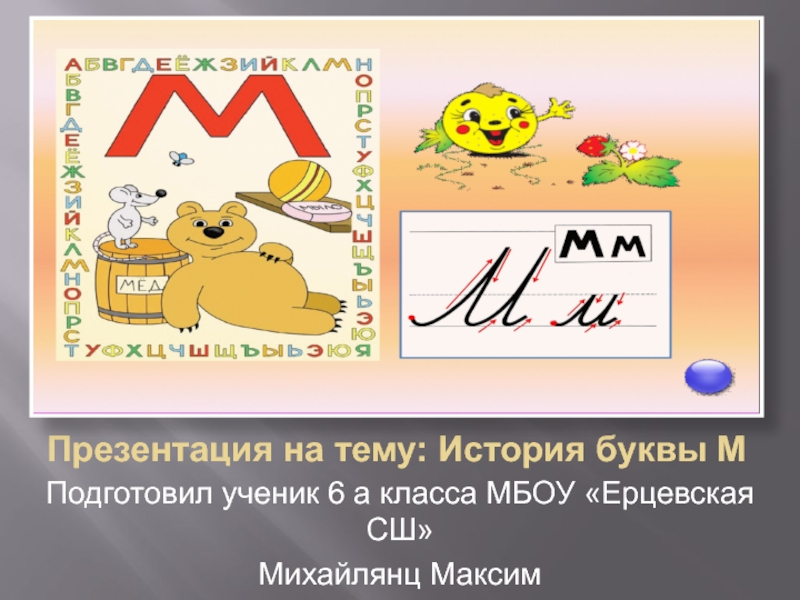Разделы презентаций
- Разное
- Английский язык
- Астрономия
- Алгебра
- Биология
- География
- Геометрия
- Детские презентации
- Информатика
- История
- Литература
- Математика
- Медицина
- Менеджмент
- Музыка
- МХК
- Немецкий язык
- ОБЖ
- Обществознание
- Окружающий мир
- Педагогика
- Русский язык
- Технология
- Физика
- Философия
- Химия
- Шаблоны, картинки для презентаций
- Экология
- Экономика
- Юриспруденция
Тимофеева А.А. 2018 © 1 Methods of comparable data obtaining
Содержание
- 1. Тимофеева А.А. 2018 © 1 Methods of comparable data obtaining
- 2. Methods of comparable data obtainingCurrency conversionAverage annual
- 3. PPP (purchasing power parity)A Prototype Is The "Big Mac"Тимофеева А.А. 2018 ©
- 4. 3200 main consumer of goods and services236
- 5. When PPP?Cross-country comparisonsRational allocation of limited funds
- 6. Сomparable price levelТимофеева А.А. 2018 ©
- 7. Price level ratio of PPP conversion factor (GDP) to market exchange rateТимофеева А.А. 2018 ©
- 8. Тимофеева А.А. 2018 ©List by the International Monetary Fund (Estimates for 2017)
- 9. Тимофеева А.А. 2018 ©Proportion of countries by GDP PPPChinaUSAIndiaJapanGermanyRussiaBrazilIndonesiaGreat Britain
- 10. Сlassification of the countries
- 11. 195 countries, 72 dependent areas Country =
- 12. Signs of dependent areasAdvantages for mother-countryAdvantages for dependent area
- 13. Group of countriesDeveloped countriesDeveloping countriesTransition economy(?)5
- 14. Criteria:The nature of the economyThe level of socio-economic development6
- 15. Sectoral structure of GDP as an indicator
- 16. Sectoral structure of GDP as an indicator
- 17. The level and quality of lifeLifespanThe incidencePersonal
- 18. ИРЧП 2013Russia – 50, 0,798
- 19. World map indicating the Human Development Index (based on 2014 data, published on December 14, 2015)
- 20. Approximate characteristics of developed countries 1) GDP
- 21. 4) Evolution towards domination of the industry
- 22. 7) Business structure is non-uniform. The leading
- 23. 9) The state of developed countries is
- 24. 10) The openness to the world economy
- 25. Countries with economies in transition: The former
- 26. The term "transition economy" is used to
- 27. Exemplary characteristics of developing countriesThe low level
- 28. 5) The agricultural profile of the economy
- 29. The classification of the International Monetary Fund
- 30. Major industrialized country, or "Big seven"?11.4% of
- 31. Слайд 31
- 32. Тимофеева А.А. 2018 ©The PwC The World in
- 33. Тимофеева А.А. 2018 ©The PwC report also
- 34. Тимофеева А.А. 2018 ©
- 35. Тимофеева А.А. 2018 ©
- 36. Тимофеева А.А. 2018 ©Challenges for policymakersProtectionismBenefits of globalisation equityGreen technologies
- 37. Тимофеева А.А. 2018 ©Opportunities for business :Mature emerging markets (costs, consumers, B2B)
- 38. «Other emerging market and developing countries»146 countries,
- 39. Sub-group "Other emerging market and developing countries"exporters
- 40. The classification of the world BankGNI per
- 41. 207 countries
- 42. The state of external debtPoor countries with
- 43. Слайд 43
- 44. Слайд 44
- 45. Слайд 45
- 46. Слайд 46
- 47. 2015
- 48. Слайд 48
- 49. Слайд 49
- 50. Слайд 50
- 51. Слайд 51
- 52. Скачать презентанцию
Слайды и текст этой презентации
Слайд 2Methods of comparable data obtaining
Currency conversion
Average annual exchange rate
The purchasing
power parity
2018 ©Слайд 43200 main consumer of goods and services
236 main investment products
16
typical construction projects
Тимофеева А.А. 2018 ©
PPP (purchasing power parity)
Слайд 5When PPP?
Cross-country comparisons
Rational allocation of limited funds (quotas of the
IMF)
The identification of appropriate exchange rates for countries opening their
economiesТимофеева А.А. 2018 ©
Слайд 7Price level ratio of PPP conversion factor (GDP) to market
exchange rate
Тимофеева А.А. 2018 ©
Слайд 9Тимофеева А.А. 2018 ©
Proportion of countries by GDP PPP
China
USA
India
Japan
Germany
Russia
Brazil
Indonesia
Great Britain
Слайд 11195 countries, 72 dependent areas
Country = economy
≠ state
The number
of States and dependent territories in the world
Colony = "dependent
territory"Neocolonialism
Слайд 15Sectoral structure of GDP as an indicator of the level
of socio-economic development
The level and quality of life
GDP/GNI per capita
The
level of socio-economic development7
Слайд 16Sectoral structure of GDP as an indicator of the level
of socio-economic development of the country
High level
development => tertiary sectorsecondary sector =>manufacturing
Developing = > if tertiary - tourism, trade
if secondary - mining
8
2004:
1:2:3 %
USA: 2:23:75
Russia: 5:34:61
India: 23:26:52
2013:
1:2:3 %
USA: 1:20:79
Russia: 4:38:58
India: 17:26:57
Слайд 17The level and quality of life
Lifespan
The incidence
Personal safety
Natural environment
Unemployment
Consumption
Human development
index
Lifespan
The level of education
The level of GDP
9
Слайд 19
World map indicating the Human Development Index (based on 2014 data, published
on December 14, 2015)
Слайд 20Approximate characteristics of developed countries
1) GDP per capita is on
average about 30 thousand dollars and it is growing =>
3)
Social support – the "middle class" who share the values and basic foundations of society2) A high level of consumption and investment and the standard of living of the population as a whole
Слайд 214) Evolution towards domination of the industry and the trend
of transformation of the industrial economy in the post-industrial
5) Growing
service sector , and the share of the population employed in it is leading6) Technological progress has a significant impact on economic growth and the structure of the economy
Approximate characteristics of developed countries
Слайд 227) Business structure is non-uniform. The leading role in the
economy belongs to powerful corporations – TNCs
8) The wide distribution
of small and medium business as factor of economic and social stability. This business employs up to 2/3 of the economically active population. In many countries, small businesses provide up to 80% of new workplaces and affects the sectoral structure of the economyApproximate characteristics of developed countries
Слайд 239) The state of developed countries is an active participant
in economic activity
Approximate characteristics of developed countries
Слайд 2410) The openness to the world economy and the liberal
organization of the foreign trade regime
11) In the field of
international labour migration, developed countries act as the receiving partyApproximate characteristics of developed countries
Слайд 25Countries with economies in transition:
The former socialist countries of
Central and Eastern Europe:
Albania, Bulgaria, Hungary, Poland, Romania, Slovakia,
Czech Republic, successors of the Socialist Federal Republic of Yugoslavia — Bosnia and Herzegovina, Republic of Macedonia, Slovenia, Croatia, Serbia and Montenegro; The former Soviet republics, now the CIS countries:
Azerbaijan, Armenia, Belarus, Georgia, Kazakhstan, Kyrgyzstan, Moldova, Russian Federation, Tajikistan, Turkmenistan, Uzbekistan, Ukraine;
The former Baltic republics: Latvia, Lithuania, Estonia.
A particular challenge is the classification of China, since the building of capitalism and, therefore, market relations is under the leadership of the Communist party of China (CPC).
Слайд 26The term "transition economy" is used to describe the transformation
of the socialist economy to the market one.
The transition
to the market :Exemplary characteristics of transition countries
The deregulation of the economy, requiring privatization and stimulation of development of private enterprises;
The development of non-state forms of ownership, including private ownership on the means of production;
The formation of the consumer market and the saturation of its products
The experience of “shock therapy” is not a guarantee of a strong economy
Слайд 27Exemplary characteristics of developing countries
The low level of socio-economic development
1)
Suppliers of raw materials and fuels on the world market
2)
As suppliers of raw materials depend on import of finished products3) The economy's dependence on TNCs
4) The low level of development of productive forces, backwardness of technical equipment of industry, agriculture and social infrastructure
Слайд 285) The agricultural profile of the economy and the share
of the population employed in agriculture
6) Poverty, overpopulation, high
unemployment7) Economic role of the state is large and along with the traditional functions include:
The exercise of national sovereignty over natural resources;
Control over foreign financial assistance;
Agrarian transformation associated with increased agricultural production, creation of cooperatives, etc.;
Exemplary characteristics of developing countries
Слайд 29The classification of the International Monetary Fund
2 groups of
countries
Major industrialized country,
or "Big seven"
Euro area countries
+ Hong
Kong Taiwan
The Vatican
Faroe Islands
Bermuda
Liechtenstein
Monaco
San Marino
Andorra
«Industrialized countries»
«Other emerging market and developing countries»
Australia
Austria
Belgium
Germany
Greece
Denmark
Ireland
Spain
Italy
Canada
Netherlands
New Zealand
Norway
Portugal
United Kingdom
USA
Finland
France
Switzerland
Sweden
Japan
Cyprus
Czech Republic Iceland
Israel
South Korea Luxembourg
Malta
Singapore
Slovakia
Slovenia
Слайд 30Major industrialized country,
or "Big seven"
?
11.4% of the population
50%
of the WGDP 42,3% of the global trade, PPP
Слайд 32Тимофеева А.А. 2018 ©
The PwC The World in 2050 report suggests that emerging
markets will constitute many of the world’s top ten economies by
gross domestic product (GDP) and purchasing power parity (PPP) by 2050.Слайд 33Тимофеева А.А. 2018 ©
The PwC report also looks at the
fastest growing economies between 2016 and 2050, which include frontier
markets by today’s definition.Слайд 36Тимофеева А.А. 2018 ©
Challenges for policymakers
Protectionism
Benefits of globalisation equity
Green
technologies
Слайд 37Тимофеева А.А. 2018 ©
Opportunities for business :
Mature emerging markets (costs,
consumers, B2B)
Слайд 38«Other emerging market and developing countries»
146 countries, 85% of the
population, 60% of the WGDP, 65% of world trade
Слайд 39Sub-group "Other emerging market and developing countries"
exporters of liquid fuel;
b) exporters of other raw materials;
c) exporters of industrial
finished products; d) exporters of services;
e)financial criteria: countries export capital and import of capital;
f)countries not exporting oil
Criteria:
Слайд 40The classification of the world Bank
GNI per capita
3 groups:
Countries with
low income
Crane middle-income
Countries with high income
Countries with above-average income
Country lower
middle incomeThe relationship between poverty, child mortality and economic performance
Слайд 42The state of external debt
Poor countries with largest external debt
Countries
with moderate debt
Countries with a small debt
Largest external debt
80% of
the GNI220% for export
Moderate debt
>60%



